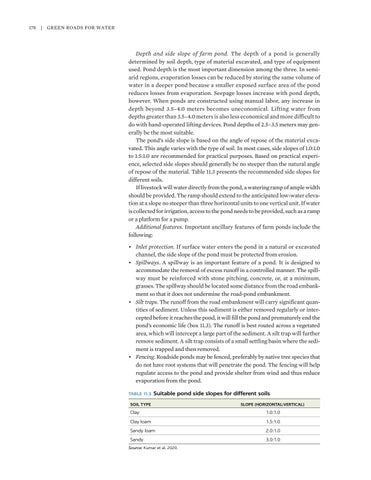178 | Green Roads for Water
Depth and side slope of farm pond. The depth of a pond is generally determined by soil depth, type of material excavated, and type of equipment used. Pond depth is the most important dimension among the three. In semiarid regions, evaporation losses can be reduced by storing the same volume of water in a deeper pond because a smaller exposed surface area of the pond reduces losses from evaporation. Seepage losses increase with pond depth, however. When ponds are constructed using manual labor, any increase in depth beyond 3.5–4.0 meters becomes uneconomical. Lifting water from depths greater than 3.5–4.0 meters is also less economical and more difficult to do with hand-operated lifting devices. Pond depths of 2.5–3.5 meters may generally be the most suitable. The pond’s side slope is based on the angle of repose of the material excavated. This angle varies with the type of soil. In most cases, side slopes of 1.0:1.0 to 1.5:1.0 are recommended for practical purposes. Based on practical experience, selected side slopes should generally be no steeper than the natural angle of repose of the material. Table 11.3 presents the recommended side slopes for different soils. If livestock will water directly from the pond, a watering ramp of ample width should be provided. The ramp should extend to the anticipated low-water elevation at a slope no steeper than three horizontal units to one vertical unit. If water is collected for irrigation, access to the pond needs to be provided, such as a ramp or a platform for a pump. Additional features. Important ancillary features of farm ponds include the following: • Inlet protection. If surface water enters the pond in a natural or excavated channel, the side slope of the pond must be protected from erosion. • Spillways. A spillway is an important feature of a pond. It is designed to accommodate the removal of excess runoff in a controlled manner. The spillway must be reinforced with stone pitching, concrete, or, at a minimum, grasses. The spillway should be located some distance from the road embankment so that it does not undermine the road-pond embankment. • Silt traps. The runoff from the road embankment will carry significant quantities of sediment. Unless this sediment is either removed regularly or intercepted before it reaches the pond, it will fill the pond and prematurely end the pond’s economic life (box 11.3). The runoff is best routed across a vegetated area, which will intercept a large part of the sediment. A silt trap will further remove sediment. A silt trap consists of a small settling basin where the sediment is trapped and then removed. • Fencing. Roadside ponds may be fenced, preferably by native tree species that do not have root systems that will penetrate the pond. The fencing will help regulate access to the pond and provide shelter from wind and thus reduce evaporation from the pond. TABLE 11.3 Suitable
pond side slopes for different soils
SOIL TYPE
SLOPE (HORIZONTAL:VERTICAL)
Clay
1.0:1.0
Clay loam
1.5:1.0
Sandy loam
2.0:1.0
Sandy
3.0:1.0
Source: Kumar et al. 2020.







































